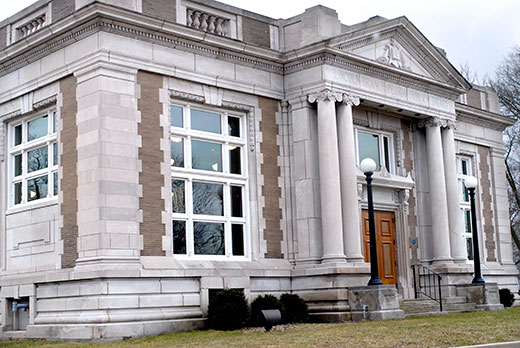In 2008, a ballot referendum passed with 72 percent approval to improve the library facilities throughout the Peoria Public Library system. Evidenced by this action, voters in Peoria made a public statement that all Peorians should have equal access to quality library services. This sentiment is one that is woven in the history and architecture itself of the Lincoln Branch of the Peoria Public Library, 1312 W. Lincoln Ave.

The Lincoln Library, a branch of the Peoria Public Library, opened in 1911, and was placed on the National Registry of Historic Places by the National Park Service in 2014. Andrew Carnegie helped fund the original library built in the Neoclassical Revival style with ionic columns, strong quoins and a prominent front pediment.
At the turn of the last century, industrialist turned philanthropist Andrew Carnegie reflected his belief that access to knowledge could better the lives of people. With this philosophy, he helped fund approximately 1,600 free access libraries across the country. Local newspaper owner Henry Pindell led community leaders to approach Carnegie, and the Lincoln Library was opened to the public in 1911.
The Neoclassical Revival style was a perfect choice for architects Hotchkiss & Harris. Its almost temple like appearance displays the importance of the library within the community. Ionic columns, strong quoins, deeply carved dentil moldings and a prominent front pediment are easily visible. With a symmetrical design of limestone and light brick set with strong vertical and horizontal lines there is an importance given to the facade. Adding more visual impact, the building is raised a half story on its foundation and placed within a park setting. Carnegie believed that a person had the potential to better themselves through learning and often, as is this example, a prominent set of steps leads to the building’s front door. One thing also notable on this Neoclassical design is the use of windows. Not only utilitarian for illumination inside the building, the size of the windows, set by strong limestone casings, reflected the impression that the knowledge contained inside was accessible and would help draw patrons inside.
Over the years, this branch has continued to serve and anchor the south side of Peoria. In 1970, as talk of closing this branch surfaced because of lower circulation and perceived changes in the neighborhood, local resident Kathleen Ditewig organized a public campaign, ultimately keeping the Lincoln Library open. The library has gone through two major remodels with a 12,000-square-foot addition being added in 2010. This addition was done in such a way to preserve the integrity of the original Carnegie Library yet expanding meeting space, internet accessibility and other community services.
In 2014, the library was placed on the National Registry of Historic Places by the National Park Service. While many communities have lost their Carnegie Libraries, the legacy of the Lincoln Branch Library continues to be about access: access to education, access to community and access to changing ways of getting information.
On another note
With a hit Broadway show and recent biographies about his life, recent attention has been placed on Founding Father Alexander Hamilton. While he was never to set foot in Peoria, our city does have a connection through his son William. He is responsible for laying out Peoria’s original grid of 16 blocks in 1826, including the broad thoroughfare “Hamilton Avenue.”

Recent Comments